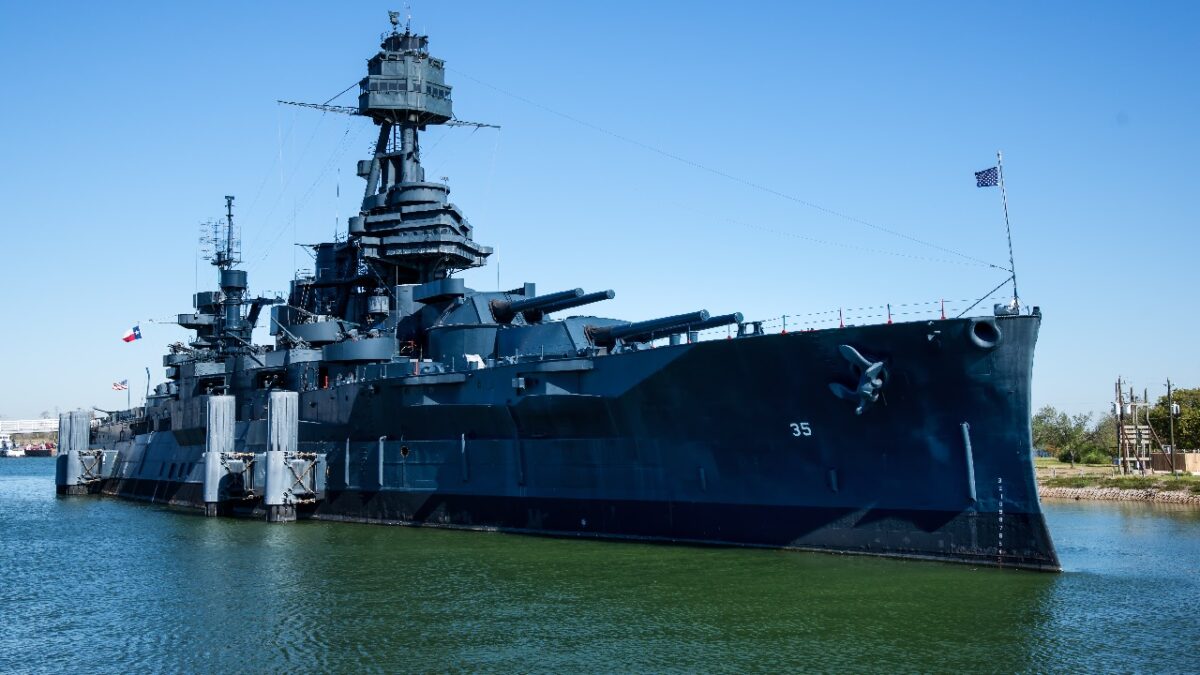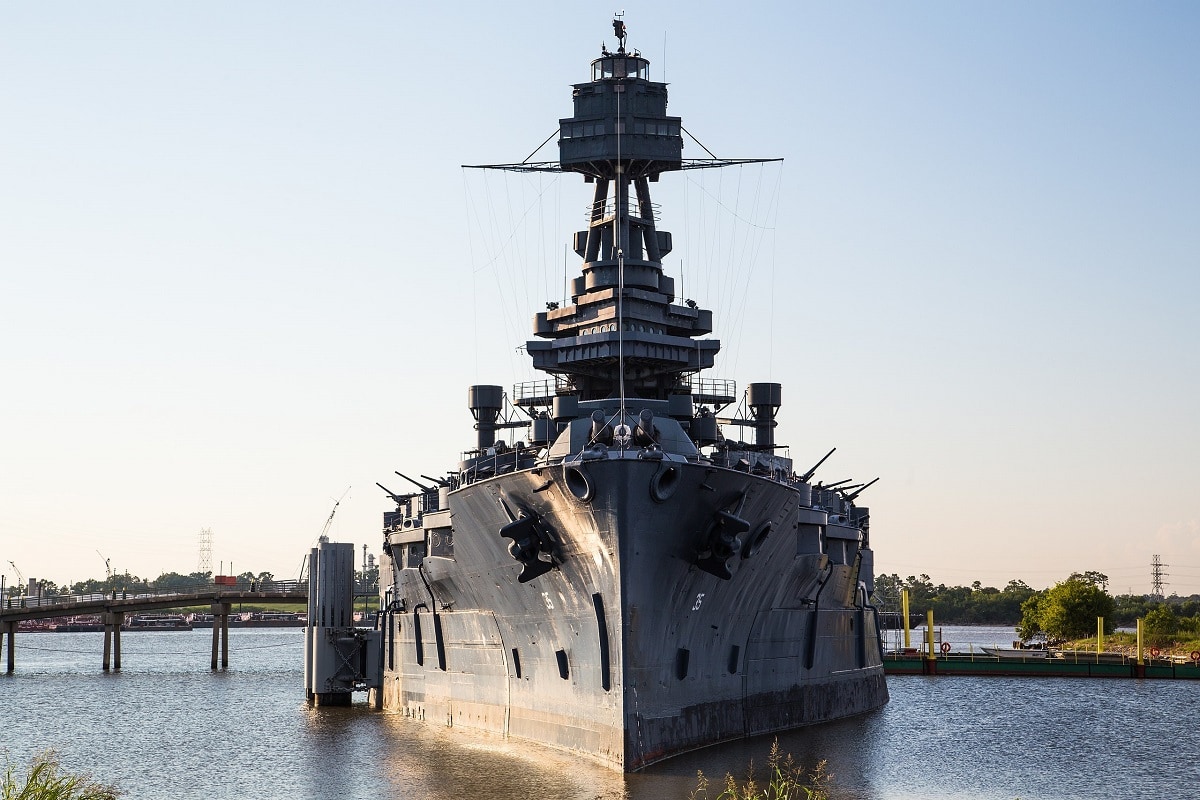A Warship of Firsts – The USS Texas – The USS Texas (BB-35), the last remaining dreadnought battleship in existence and the only surviving warship to see service in both World Wars, was almost lost in recent years. However, it wasn’t from a foreign enemy, but rather time and the elements. The good news is she looks like she is on the comeback trail.
USS Texas: Father Time Can Even Takedown Battleships
After being retired following the Second World War, she became the nation’s first battleship to be turned into a floating museum and was transferred to the Lone Star State. Since April 21, 1948, the gallant warship was located in the Houston Ship Channel near the San Jacinto Battleground Memorial – the location where Texian troops led by Gen. Sam Houston surprised and quickly defeated the Mexican Army in 1836.
It was considered a fitting location for what became the honorary flagship of the Texas Navy.
However, all those decades spent in the water had taken their toll on the old battle wagon, and in June 2017, a six-by-eight-inch hole about fifteen feet below the waterline opened and caused the USS Texas to list six degrees. The situation was so dire that there were concerns the ship could sink. Fortunately, work has been taken to ensure that the warship won’t be lost to the elements.
Future Plans
BB-35 is currently across at Gulf Copper Dry Dock & Rig Repair near Galveston where restoration on the USS Texas began a year ago. Most of the repairs will be funded by a $35 million federal grant.
A number of suitable locations have been considered for the future home of the historic vessel.
Earlier this month, it was announced that the Battleship Texas Foundation was just two months away from an agreement to keep the ship at Pier 21, near the Galveston Historic Seaport, which is also home to the 1877 Tall Ship ELISSA. A few issues may need to be addressed first.
“We remain focused on working to make Galveston the home berth for the Battleship Texas and we are hopeful an equitable agreement for all parties can be reached in the coming months,” Battleship Texas Foundation President Tony Gregory said in a statement to KHOU 11 news.
While the Repairs Continue
Even as the ship undergoes repairs, there are unique opportunities for history buffs to experience the vessel in a way not previously available.
The foundation is running dry dock tours every Sunday through December, while an exhibit on USS Texas will run until the end of January at the Galveston Railroad Museum – sharing the story of the battleship through her career in both World Wars.
A True and Mighty Warship
The New York-class warship’s main battery featured ten 14-inch 45-caliber guns capable of firing 1,400-pound armor-piercing shells up to 13 miles; the secondary battery was outfitted with 5-inch 51-caliber guns. In addition, BB-35’s torpedo rooms housed 12 torpedoes as well as 12 naval defense mines.
She was first deployed during the “Tampico Incident,” which involved the United States occupation of Vera Cruz, and she began fleet operations after America’s entry into the First World War. She joined the Grand Fleet and provided support for the British Squadron. Though she did see significant combat action, she still was part of the Battleship Force of the Atlantic Fleet.
The next war was to be much different.
USS Texas took part in her first combat operations of the Second World War as part of Task Group 34.8 (TG 34.8) in support of Operation Torch, the Allied invasion of North Africa. Texas transmitted Lt. General Dwight D. Eisenhower’s first “Voice of Freedom” broadcast, which called up the Vichy French forces defending Morocco not to oppose the Allied landings. In addition, as a young news reporter, Walter Cronkite was among those onboard the battleship during the operations and was even granted permission to fly off of the ship in one of her OS2U Kingfisher aircraft.
The aging battleship returned to Atlantic convoy escort duties and was among the warships to provide supporting fire during the Normandy landings. The battle wagon also participated in the bombardment of Cherbourg, during which she was hit by enemy coastal artillery fire but suffered no serious damage.
After undergoing repairs in Plymouth, England, she took part in the Allied invasion of the South of France during Operation Dragoon. Following an overhaul in New York City, which involved replacing her main battery barrels, the USS Texas returned to the Pacific and later provided naval gunfire support during the Battles of Iwo Jima and Okinawa.
The vessel earned a total of five battle stars for her service in the Second World War.
Historic Firsts and Notable Improvements
USS Texas is also noteworthy for the technological improvements and advancements that were made during the course of service with the U.S. Navy.
When she and her sister warships were constructed, U.S. turbine manufacturers were unwilling to meet the strict specifications laid down by the Navy Department’s Bureau of Ships. Since no compromise could be made on standards and prices, the Bureau had to revert to the older reciprocating engines for the New York-class battleships. That use of the machinery actually may have given up to 30 percent improvement in economy at cruising speed, and in no way was inferior at full speed.
In addition, USS Texas proved to be an ideal testbed for the U.S. Navy, and in March 1919, she became the first U.S. battleship to fly off an aircraft – a British Sopwith Camel – from a temporary platform that had been fitted atop her second turret.
The USS Texas subsequently underwent a major reconstruction from 1925 to 1927, and the ship was reboilered with six Bureau-Express oil-fired units. Other improvements were made to the battleship’s combat systems, and BB-35 became the first U.S. battleship to mount anti-aircraft guns, as well as the first U.S. vessel to control gunfire with directors and range-keepers.
Today Battleship Texas as she is now known, is the official – but entirely ceremonial – flagship of the Texas Navy. It now appears that thanks to the efforts to restore the ship, USS Texas is winning the war against the elements.

Author Experience and Expertise
A Senior Editor for 19FortyFive, Peter Suciu is a Michigan-based writer. He has contributed to more than four dozen magazines, newspapers, and websites with over 3,200 published pieces over a twenty-year career in journalism. He regularly writes about military hardware, firearms history, cybersecurity, politics, and international affairs. Peter is also a Contributing Writer for Forbes and Clearance Jobs. You can follow him on Twitter: @PeterSuciu.

